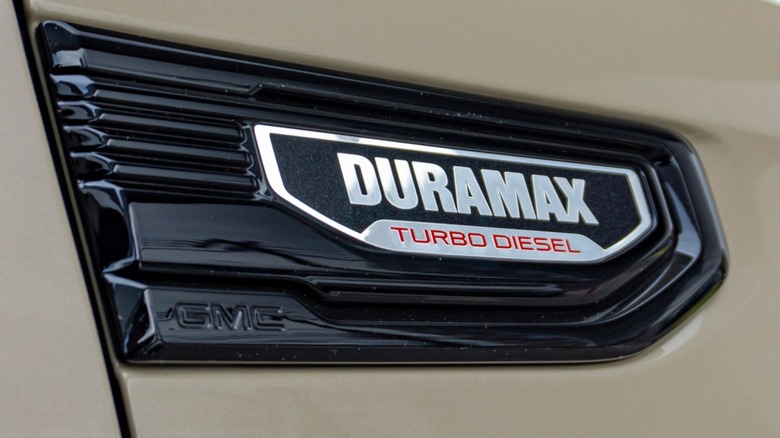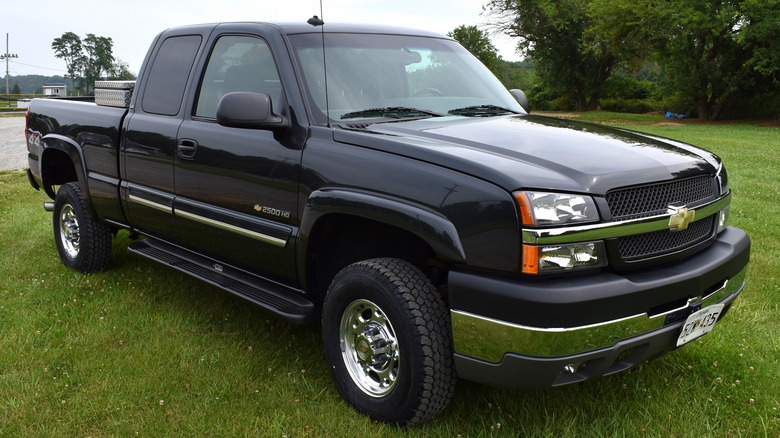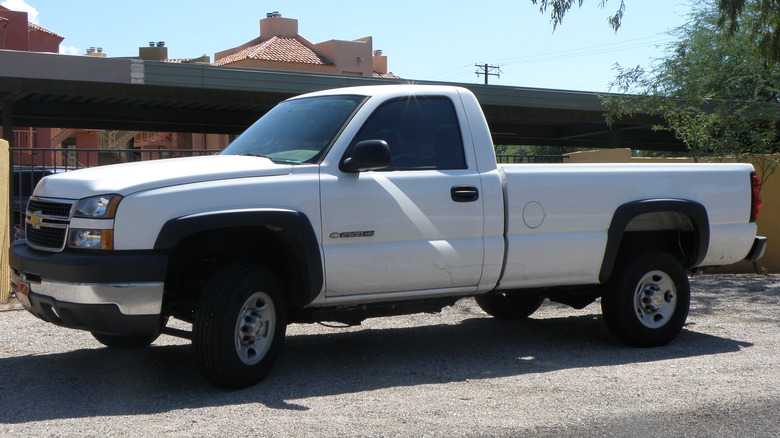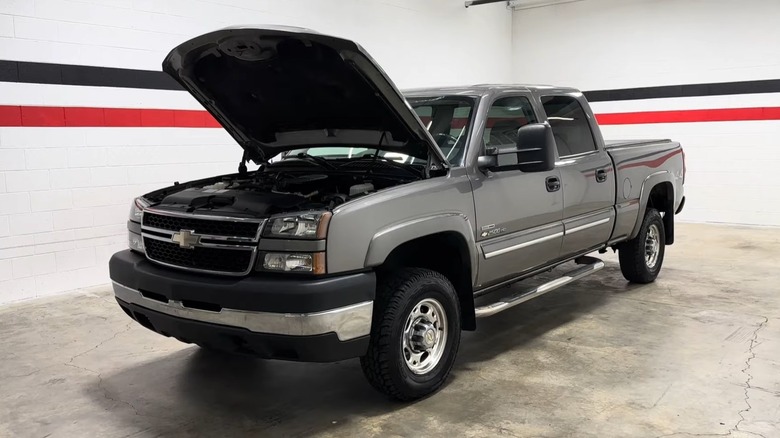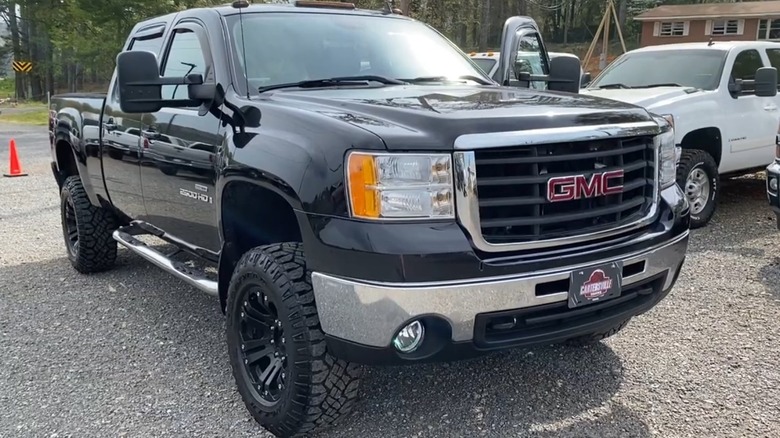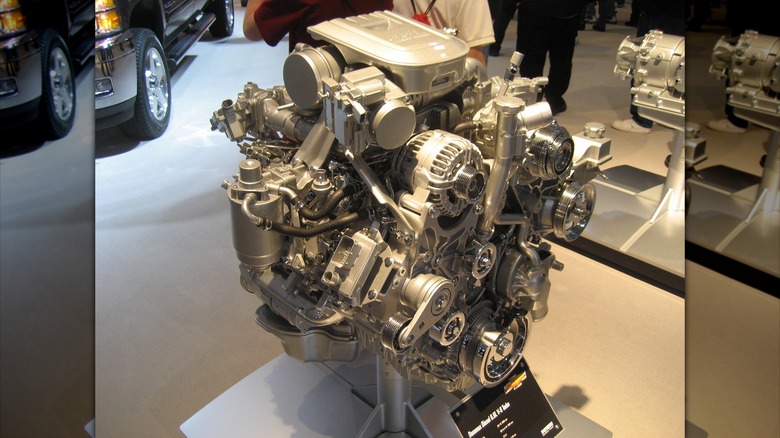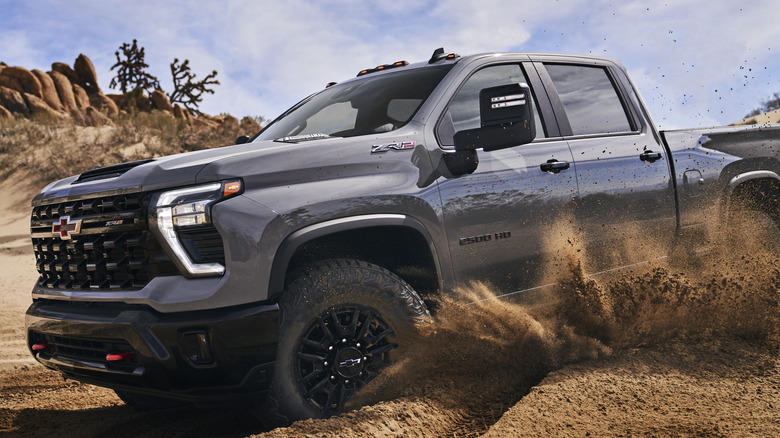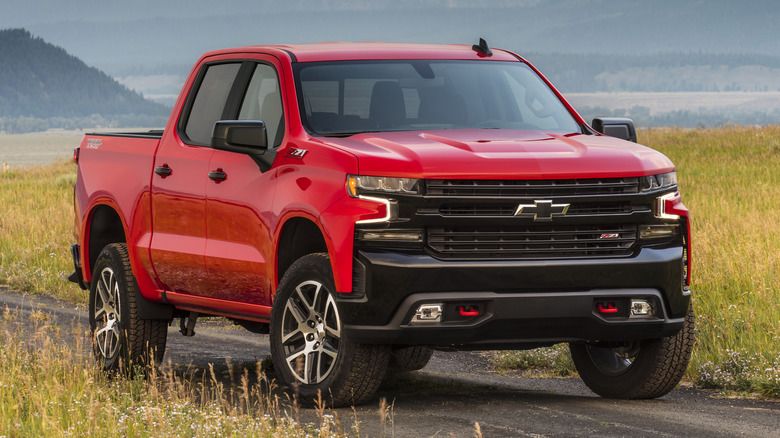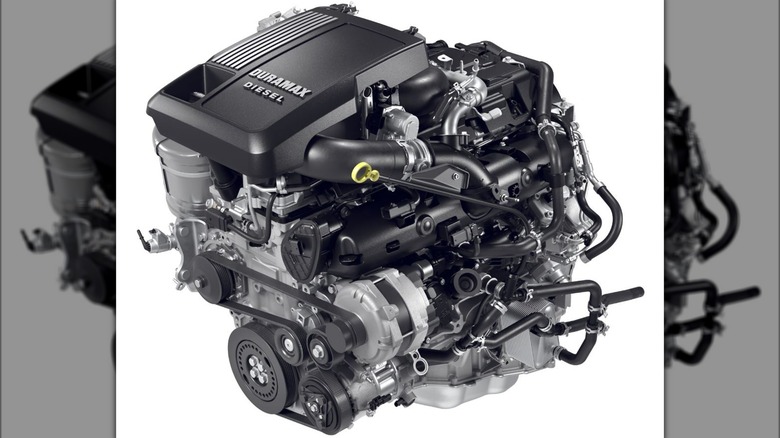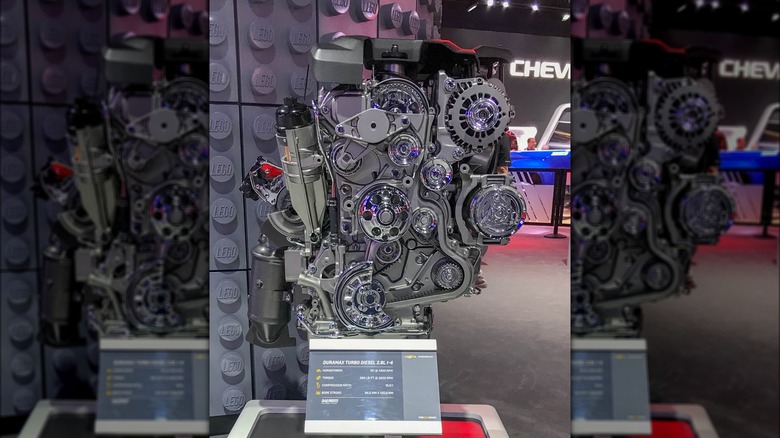The Most Reliable Duramax Diesel Engines (And Which To Avoid) According To Owners
General Motors' Duramax engine family is one of the three leading names in diesel engines, right up there with Ford's Power Stroke and Cummins' diesel engines — like the legendary Cummins 6BT — featured in Ram trucks. It's also the newest of the three, its 2001 debut making it a veritable child compared to the Power Stroke — which debuted in 1994 — and Cummins, whose engines first became popular in the 1930s.
Debuting in the form of a 6.6-liter V8, GM has expanded the family over the years to include smaller 2.8- and 3.0-liter inline-four and inline-six engines, all while constantly updating its flagship 6.6-liter V8 — with six revisions and counting, as of 2024. As you might imagine, not every engine in the range is a home run, with some being known as the most reliable diesel engines ever built, and others proving troublesome enough to be avoided.
Even the least reliable Duramax engines are still very usable if you perform routine maintenance and, in some cases, modify it. However, if you're interested in tilting the odds in your favor, let's run down the most reliable options, and the one's worth steering clear of. Remember: We're discussing engines here, not trucks, so we won't comment on fit and finish issues and other mechanical gremlins that Duramax truck owners may have faced. With that out of the way, let's get started.
Most reliable: 6.6-liter LB7 (2001 - 2004)
Chevy's first-ever Duramax diesel engine, the LB7, debuted in Chevy's ¾- and 1-ton trucks, such as the Silverado 2500HD and 3500HD, for the 2001 model year before debuting in medium-duty trucks like the GMC TopKick in 2003. The first fruit of GM's collaboration with Isuzu, the LB7 was a turbocharged 6.6-liter V8 diesel engine that made 300 hp and 560 lb-ft of torque.
Being an early-2000s diesel engine, the LB7 Duramax doesn't have any of the emissions control hardware of later engines. This makes it a popular engine for diesel fans, as emissions technologies such as exhaust gas recirculation (EGR) can affect power output and fuel economy — two reasons why some diesel owners perform EGR deletes on their engines (Duramax or otherwise).
The LB7 has one major Achilles' heel: the injectors. The LB7's injectors are known for cracking and failing past the 100,000-mile mark. Thankfully, good maintenance and improved injectors from Bosch can help, although they're still not failure-proof, something to bear in mind given injectors are expensive — over $2,000 for a full set — and labor-intensive to replace.
Despite that, many owners still love their LB7s and how simple they are, even with the injector issues. The engine often comes up when fans talk about the most reliable Duramax V8s, and as long as you're aware of what you're getting into, the LB7 is a great Duramax worth considering.
Avoid: 6.6-liter LLY (mid-2004 - 2006)
In mid-2004, Chevy followed up the LB7 with the LLY Duramax, which boasted a new injector design that made servicing much easier. Debuting in the same heavy-duty Chevy Silverado and GMC Sierra 2500 HD and 3500 HD trucks its predecessor powered, the LLY debuted at similar power numbers to the LB7 before a 2006 update kicked things up to 310 hp and 605 lb-ft of torque.
The LLY came with a new variable-vane turbo — with better throttle response than the LB7's unit — and an EGR system. Unfortunately, both seem to have contributed to the LLY's major weakness: overheating. Chevy's decision to ship the engine with a restrictive turbo intake setup and small radiator gave the LLY a reputation for overheating when towing.
Thankfully, the LLY's overheating issues seem to be fixable if you're willing to modify the engine. Installing a freer-flowing turbo mouthpiece (usually from the LBZ) is a common fix that can reduce temps and allegedly improve turbo performance. There was also an improved radiator available for a while, although it no longer seems to be in production.
If you're willing to put in the work, the LLY can be a good and reliable engine like its predecessor. But it's hard to recommend it when there are simpler Duramax engines to run.
Most reliable: 6.6-liter LBZ (2006 - 2007)
The mid-2000s was a period of rapid iteration for GM's Duramax engine. The LLY only lasted a couple of years before GM debuted an updated version of the 6.6-liter diesel with a new code name, LBZ. The LBZ debuted for the 2006 model year with an impressive 360 hp and 650 lb-ft of torque.
The LBZ featured many upgrades over the LLY, including a stronger engine block, beefier connecting rods, an improved fuel injection system, and a larger turbocharger intake. Furthermore, the LBZ would be the last Duramax without all the modern emissions control tech that hobbles the fuel economy and reliability of many modern diesel engines. This makes the LBZ one of the most sought-after Duramax engines, with eBay prices to match.
LBZs are highly regarded in the diesel community, and owners generally sing the praises of this third-generation Duramax. Not for nothing is it known as one of the most reliable V8 engines ever made, with one couple putting 1.2 million miles on their LBZ-powered truck over 10 years.
That said, the LBZ isn't perfect. The cast-aluminum pistons are a weak point and prone to cracks, especially at higher horsepower. The consensus is that the pistons are safe until around 600 to 650 hp, after which you're risking it. So the LBZ might not be the best Duramax for a drag-racing diesel, then. But if you're leaving it stock or running a more conservative tune, this is the pre-emissions Duramax to buy.
Avoid: 6.6-liter LMM (mid-2007 - 2011)
After a couple of short-lived 6.6-liter Duramax revisions, GM finally stuck with a version of the engine for more than a couple of years. The LMM Duramax V8 debuted in mid-2007 alongside the new GMT-900 platform the Chevrolet Silverado and GMC Sierra, along with a slight uptick in power to 365 hp and 660 lb-ft of torque.
The power increase came in spite of the LMM being the first Duramax subject to new diesel emissions regulations in the U.S., which came into effect on January 1, 2007. The stricter regulations meant that the LMM shipped with a larger EGR system and a diesel particulate filter (DPF). The introduction of the DPF had knock-on effects on the LMM's overall usability and reliability. For one, active regeneration of the DPF required fuel, which reduced fuel economy compared to the LBZ.
DPF regeneration also required the truck to be driven in a specific way — above 30 mph for at least 30 minutes — and it was possible to damage the filter by not completing the regeneration cycle. This could lead to clogging or failure of the filter, causing all manner of problems and further worsening fuel economy. Some enthusiasts remove the DPF and EGR on their LMM Duramaxes to fix these issues, but it's important to note that is illegal.
If you've got to break the law to make the LMM a reliable engine, it's probably better to just get a different engine.
Avoid: 6.6-liter LML (2011 - 2016)
GM's second emissions-controlled Duramax V8 bumped power levels even more when it debuted for the 2011 model year in the Chevrolet Silverado and GMC Sierra HD trucks. Despite the U.S. EPA introducing even tighter emissions regulations that year, GM's V8 diesel made 397 hp and 765 lb-ft of torque, offering a huge upgrade in towing power compared to its predecessors.
The LML had a raft of changes compared to the LMM, including new pistons, a better block, and a new fuel pump. GM also specced an improved EGR and made changes to the DPF system, which possibly helped improve fuel economy by up to 11%. However, while most of these changes made the LML much better than its predecessor, another upgrade would prove to be troublesome.
The Bosch CP4.2 fuel pump that GM used on the LML was a notable downgrade compared to the CP3 pump on previous engines. While it generated more pressure, the CP4.2 was — and continues to be — sensitive to contaminants in the fuel. Contaminants could damage the pump, sending metal shavings circulating through the fuel system and ruining it, triggering a massive repair bill.
Proper maintenance and avoiding bad diesel ownership habits can reduce the risk of the pump failing, but the most popular solution is to retrofit the old CP3 pump on the LML to bypass the problem entirely. However, most (if not all) conversion kits require you to delete the EGR — which is ilegal.
Most reliable: 6.6-liter L5P (2017 - present)
2017 saw the debut of GM's latest and greatest Duramax to date, the L5P. But while the L5P shared the 6.6-liter displacement of its predecessors, the L5P was an all-new engine that bore little similarity to legendary engines such as the LBZ Duramax beyond the identical bore and stroke.
The L5P had a new cylinder block, camshaft, turbo, fuel system (injectors and pump), uprated internals, better cooling, and ceramic glow plugs. It also came mated to an improved transmission and later received a new 10-speed unit from 2020 onward. The upshot of these changes was 445 hp and a massive 910 lb-ft of torque, climbing to 470 hp and 975 lb-ft of torque in 2024 with upgrades like a new turbo and higher-flow injectors.
The consensus from owners is that the L5P engine and the trucks it powers are solid and reliable — barring the occasional horror story — with little evidence of widespread engine-ruining faults. It's one of the most reliable 6.6-liter Duramax engines, although it's still not perfect.
The manifold absolute pressure (MAP) sensor has a tendency to soot up, which will throw up errors and possibly trigger a limp mode. Thankfully, it's a serviceable fault, with dedicated airflow sensor cleaning sprays available to help dislodge all that gunk and soot. Aftermarket parts manufacturers also sell spacer kits that help move the MAP sensor away from all the dirty recirculated exhaust from the EGR system and prolong cleaning intervals.
Avoid: 3.0-liter LM2 (2019 - 2023)
General Motors's 3.0-liter inline-six LM2 Duramax debuted in late 2019 in the Chevy Silverado 1500 and GMC Sierra 1500. The LM2 produced 277 hp and 460 lb-ft of torque in both trucks and later debuted in a larger range of GM vehicles — such as the Chevy Tahoe, Cadillac Escalade, and GMC Yukon — in 2021.
The LM2 was a clean-sheet design with little resemblance to its siblings. For one, GM opted for an aluminum engine block and cylinder head to keep the weight down, unlike the cast-iron engine blocks of the larger Duramax engines. GM engineers also eliminated the DPF, combining it with the selective catalytic reduction (SCR) function into a single unit. Stop/start also debuted on the LM2 to help improve efficiency and fuel economy.
There are a few common problems with the 3.0 Duramax engine. First is a crank issue where the engine either takes a long time to start or doesn't start at all — with GM's fixes not necessarily addressing the issue. Despite the lack of a DEF, the emissions system can also go bad, throwing up error codes due to what seems like faulty sensors. Oil consumption is also quite high, with potential oil leak issues not helping.
There's also the oil pump belt, which is at the back of the engine and incurs hefty labor costs when it needs replacing. GM recommends replacing the oil belt every 150,000 miles. While owner opinions are quite positive despite these issues, we feel that the LM2 is possibly one to avoid in favor of its successor.
Too soon to tell: 3.0-liter LZ0 (2023 - present)
In 2023, GM updated its 3.0-liter LM2 engine with a raft of changes, with which came a new LZ0 code. The LZ0 inline-six replaced the LM2 for the 2023 Chevy Silverado 1500 and GMC Sierra 1500 and will debut in full-size SUVs like the Chevrolet Tahoe and Suburban for the 2025 model year.
The headline improvement from the LM2 to the LZ0 is the power output, with horsepower climbing to 305 hp and torque increasing to 495 lb-ft. GM's Duramax engineers made several changes to the LZ0, including new pistons (which bumped compression up to 15.2:1), a new fuel injector design, an extra DEF injector, a new cylinder head, and a more powerful water pump. The oil pump belt is still in the same troublesome place, but GM increased the suggested service interval to 200,000 miles, which should hopefully make the LZ0 cheaper to maintain overall.
GM's new 3.0-liter Duramax is still very new as far as diesel engines go, so it's too soon to make any serious judgments about its reliability. Owner experiences are somewhat divided: Some LZ0 owners haven't had any real issues and, while others have experienced sensor and DEF system problems pretty much right out of the gate. One issue to watch out for is the wiring harness, which, on GMC's AT4 trucks at least, is pulled too tightly around the engine and can cause the truck's electrics to go haywire.
Most reliable: 2.8-liter LWN (2016 - 2022)
The 2.8-liter inline-four LWN was a Thailand-built engine with an interesting story. Based on a VM Motori engine called the A428 and sharing some heritage with the Jeep Liberty 2.8-liter diesel, the LWN engine started life as the XLD28 for the Thai market in 2012. It made 177 hp and 320 to 350 lb-ft of torque.
The XLD28 eventually made its way to the U.S. for GM's mid-size pickups and SUVs, such as the 2016 Chevy Colorado and GMC Canyon. In this form, it made 181 hp and 369 lb-ft of torque and was allegedly the cleanest diesel truck engine GM had ever made.
Opinions on the baby Duramax are positive overall, with owners generally happy with their LWN Duramax-powered trucks. That said, one common complaint seems to be with the emissions system. The diesel exhaust fluid (DEF) sensors and DPF seem to be common points of failure, with even those who enjoy their LWN-powered trucks fully admitting to having had these parts fail. It's not a catastrophic issue, though, and won't damage the engine.
A much more serious issue, however, is the turbo's tendency to fail on the LWN, with bent fins requiring a replacement turbo. However, good maintenance should help keep it — and the entire engine — running fine, so it's an engine to check out if you're after a small diesel.
The biggest problem, at least if you're looking to buy new, is that GM discontinued the engine after the 2022 model year.
